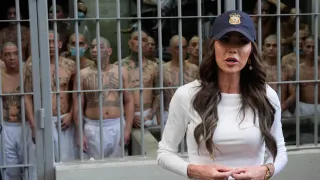
Jul 29
Bellingham: A haven for bikers and badass ladies
Nova Berger READ TIME: 1 MIN.
Need a getaway? Consider Bellingham. Framed by rugged mountains and sparkling waters, it offers an escape, a chance to slow down and enjoy the simple pleasures of life.
Bellingham is also home to an intriguingly inclusive and curious population. Situated between two of the region’s most Queer-friendly cities, Vancouver and Seattle, Bellingham is a “granola Gay” hub and a safe haven for LGBTQIA+ people in the Northwest: 40-50% of the population of Western Washington University self-identifies as Queer. The city even has its own Pride for the younger generation in June.
“I can walk the streets of Bellingham in drag,” said Betty Pages, the iconic founder of the Bellingham drag scene. “I have for years without fear. And at the very least, in all of the downtown bars, the staff will have your back... There really is no such thing as an unfriendly bar in the downtown area. That is so cool. It really is wonderful.”

Pride weekend
The weekend of July 11 certainly encapsulated that feeling. Bellingham's pride was on display in an accumulation of color, tunes, and brews.
The main event, “Pride IN Bellingham,” brought thousands downtown for a joyful parade and festival at Depot Market Square. With over 130 vendors, drag performances, and speeches BY community leaders like Selene Etheredge of Trans Survival and author Nova Martin, the festival showcased the richness of Bellingham’s LGBTQIA+ culture.
Miss Pages, as she’s done for years, opened the festival with vibrant celebration of drag culture, featuring high-energy lip-syncing to Queer anthems, engaging humor, and vintage pinup-inspired costumes.
Locally owned businesses like Ragfinery, Off the Top Studio, MW Soapworks, and Rumors Cabaret added flair to the festivities, offering community as much as commerce. Free drag shows, all-ages dances, and open-air joy made the weekend a living, dancing testament to resilience.
There was even a chance to get your snuggle on. Free Mom Hugs, a grassroots organization, literally offered hugs from mothers as a visible reminder that everyone deserves compassion.

Badass energy
But Bellingham isn’t a stranger to badass energy.
Some of the country's most recognizable female mountain bikers hail from “the City of Subdued Excitement,” such as Olympian and Crankworx champion Jill Kintner, who now lives and rides locally, and her partner Bryn Atkinson, a former World Cup downhill racer. Angi Weston, a nationally recognized coach, leads women's and youth programs through Radical Roots MTB, helping grow the next generation of riders.
One standout is Matilda “Tilly” Melton, a teenage prodigy who’s already competing alongside top pros. She took part in the Whatcom Mountain Bike Coalition’s iconic program Racing Flying Squirrels, a volunteer-run program that teaches girls to ride from second grade.
“Every single trail there is world-class,” said Adrian Abedon, a mountain biker in Seattle. “Unlike everywhere else, mountain biking is part of the community.”
Why is that? First of all, the city is home to Galbraith Mountain, just 10 minutes from downtown, where many Bellingham riders learn the craft. There are also many locally owned gear shops that cater to women, like Fanatik and Transition Bikes.
Finally, the climate in Bellingham is perfect to support these badass bikers. With mild winters, it’s almost always bike season, and residents embrace that lifestyle.

Northwest Tune-Up
At the 2025 Northwest Tune‑Up Festival, women athletes made a strong showing across multiple disciplines. While official rankings weren’t released for the FMB Freestyle Showdown, top female riders were featured prominently, showcasing their growing presence and talent in the mountain biking scene.
The results reflect trends toward female domination. According to Outdoor Industry Association data, women’s participation in mountain biking grew by over 30% between 2019 and 2023, outpacing growth among male riders.
The weekend also saw some epic art by women. The festival’s Makers Market showcased over 15 local artisans offering handmade goods inspired by the Pacific Northwest’s landscape and culture. A highlight was the live chainsaw carvings by Bellingham artist Leigh Woody, whose forest-inspired sculptures are integrated into the Galbraith Mountain trails.
The Noisy Waters Mural Stage hosted live mural painting by artists such as Seattle’s Stevie Shao and Nora Bruhn from the Bay Area, adding colorful, dynamic art that captured the spirit of Bellingham.
Many vendors featured apparel. One such brand, Wild Rye, means to empower women and Nonbinary people by focusing on clothes for them. Founded in 2016 by Sun Valley outdoor enthusiast Cassie Abel, its products range from fun-in-the-sun casual wear to garden-inspired hardcore bike gear.
Northwest Tune-Up was also a celebration of inclusive music, with beats and artists from all walks of life. Headliner Brother Ali channeled the emotion of the event. Legally blind, Muslim, and albino, he’s seen his fair share of injustice. Saturday's show was a reflection of his inner anger, a critique of systematic oppression.
“Welcome to the United Snakes, home of the thief / Land of the slave, grand imperial guard, where the dollar is sacred and power is God.” he sang.
But Ali’s set was also a reminder of hope.
“They say every person is a story full of plot twists / And we are connected like a team, by what our heart gives.”
His lyrics were raw yet humorous, a reminder that sometimes the worst part of life are easier when not taken too seriously.
All in all, Bellingham sure is the place to be for biker babes, Gay baddies, rap lovers, or anyone in between. Whether you’re tearing up the mountain trails, dancing in drag downtown, or simply soaking in the vibrant spirit, Bellingham is a place where everyone can find their tribe.
So pack your gear, bring your pride, and get ready to experience the Northwest’s ultimate playground for bold living and fierce belonging, where the goal is always to share the ride with pride!
Support the Seattle Gay News: Celebrate 51 Years with Us!
As the third-oldest LGBTQIA+ newspaper in the United States, the Seattle Gay News (SGN) has been a vital independent source of news and entertainment for Seattle and the Pacific Northwest since 1974.
As we celebrate our 51st year, we need your support to continue our mission.
A monthly contribution will ensure that SGN remains a beacon of truth and a virtual gathering place for community dialogue.
Help us keep printing and providing a platform for LGBTQIA+ voices.
How you can donate!
Using this link: givebutter.com/6lZnDB
Text “SGN” to 53-555
Or Scan the QR code below!







